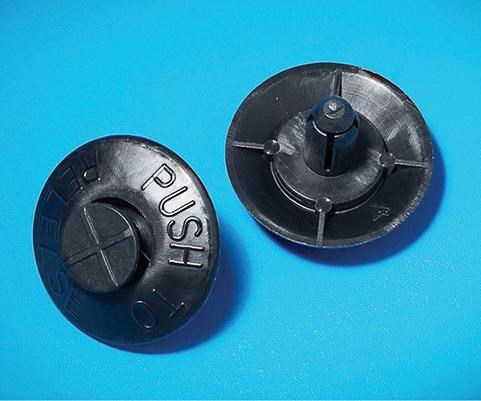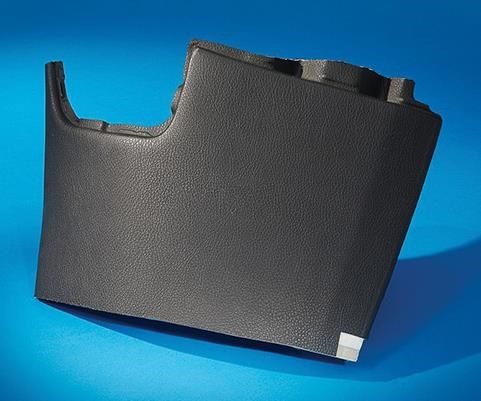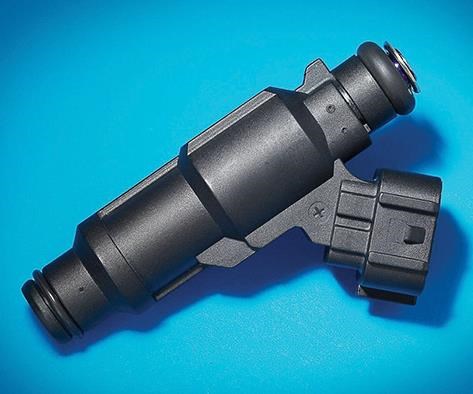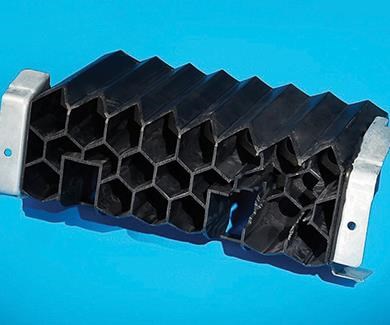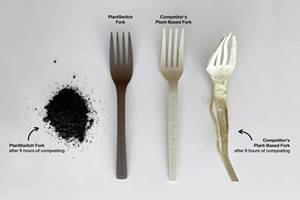Several ‘Firsts’ Among 2015 SPE Automotive Innovation Awards
CLOSE-UP: AUTOMOTIVE
Of the nine award categories, thermoplastics captured five winners.
Spanning nine categories, the winners of the SPE Automotive Division’s 2015 Blue Ribbon Automotive Innovation Awards (which this editor helped judge) represent a number of “firsts” in metal replacement and in replacing earlier plastic solutions with more capable ones. Thermoplastics played a lead role in five of the awards, which have one other thing in common—they’re all colored black. With one exception, these are functional, rather than appearance, parts.
AUTO INTERIOR: LIVING HINGE PROTECTION
The Ford 2015 F-150 pickup features a rear-seat, folding head restraint that eliminates a welded steel structure and replaces it with a single-piece thermoplastic living-hinge core as its main structural component. Tier one supplier Windsor Machine Group, LaSalle, Ont., and molder Hawk Plastics, Windsor, Ont., teamed up to design and injection mold this unique head restraint using a standard random PP copolymer from Exxon Mobil Chemical, Houston.
This single-piece plastic core results in reduced thickness from 2.56 in. to 1.26 in. for improved comfort and rear visibility, plus weight savings of 1.38 lb/vehicle, while consolidating five parts into one. Tooling costs are reduced by $180, with piece price reduced by $1.50/vehicle. This technology has been applied to the 2016 Ford Explorer and is planned for at least three additional programs.
AUTO EXTERIOR: PUSH-TO-RELEASE FASTENER
The 2015 Ford Mustang features a fastener that requires only pushing the center pin to the service position to remove—an 80% reduction in removal time, compared with other easy-service fasteners, which have two twist heads to release, along with the risk of unintentional removal. The new version brings a 10% piece-cost reduction vs. comparable service fasteners on the Mustang.
Designed and made by ITW Delta Fasteners, Troy, Mich., this fastener is made of Vydyne 47H nylon 66 from Houston-based Ascend Performance Materials. The pin and body are designed not to be easily separated; however, the fastener is reusable, unlike other push pins that become damaged in the process of removal.
The chance of unintended release is reduced because it cannot back out or be removed without a customer’s deliberate action.
POWERTRAIN: HEATED-TIP FUEL INJECTOR
The 2015 Honda Fit subcompact and Honda City vehicles sold in Brazil feature a heated-tip port fuel injector that improves cold-start performance in ethanol-fueled vehicles. Its development was a joint effort between Honda Motors, Delphi Automotive (U.S. office in Troy, Mich.) and DuPont Automotive, Wilmington, Del. The Delphi Multec 3.5 technology addresses an issue that has plagued vehicles that run on 100% ethanol (E100): This fuel will not form a combustible vapor at temperatures below 55 F, so engine-starting is not possible with a conventional System. Automakers have had to add a second gasoline fuel system for starting at colder temperatures.
The new component has an electrical heater within the injector, which is energized by the vehicle controller, rapidly heating the ethanol fuel and dramatically improving vaporization while reducing emissions. This device saved $60/vehicle as well as 19.84 lb, and lowered costs significantly by eliminating a secondary gasoline sub-tank system. The heater consists of electrical circuitry printed onto the plastic injector body.
Keys to this development were the ink materials (dielectric, conductive, and resistive inks), selected for their specific thermal and adhesive properties and performance, as well as the thick-film ink-printing process. The overmold material sealed the injector. DuPont developed a high performance polyphthalamide (PPA), Zytel HTN54G35EF BKB336, to withstand heater temperatures without degradation. It is designed with low halide ion content and heat stabilization, as well as compatibility with the unique heater inks.
PROCESS/ASSEMBLY/ENABLING TECHNOLOGIES: TPO INSTRUMENT PANEL
Hyundai Motor’s 2014 Hyundai i20 supermini features the soft IMX TPO instrument panel (IP) that eliminates scratches and a hard plastic feel. Hyundai America Tech Center, Inc., Superior Township, Mich., worked with Taiwan’s tier one supplier Hyundai-Mobis, South Korean molder Hanil E-hwa, and Korean materials supplier Hanwha L&C to bring this IP to fruition by a two-shot process. A foil is back-foamed with Multiflex 3202 TPO, which is injection-compression molded with the filled PP substrate, and is then integrated with the TPO passenger-side airbag door in a second injection step. All the work is done in a single tool. The part saves $10/vehicle and reduces mass by 0.66 lb through integration of the airbag door.
SAFETY: FLOOR ROCKER REINFORCEMENT
The 2015 Jeep Renegade SUV from FCA features an industry-first plastic-metal hybrid alternative to steel floor-rocker reinforcements, which saves 45% (2.2 lb) in weight and 10% in cost. FCA worked with Italy’s tier one Proma Group, injection molder Redstamp Srl, and materials supplier SABIC in Houston, to develop this unique component.
The application involved a Noryl GTX 910 polymer alloy of PPE and nylon 6. An optimized honeycomb geometry in this plastic/metal hybrid proved to be a very efficient energy-absorbing crash-box structure. The result is a component that is E-coat capable and also very easy to assemble into the vehicle’s BIW (body-in-white or shell). Because the plastic honeycomb is integrally attached to two steel flanges during injection molding, no structural adhesives are needed.
Related Content
Prices Up for All Volume Resins
First quarter was ending up with upward pricing, primarily due to higher feedstock costs and not supply/demand fundamentals.
Read MoreAdvanced Biobased Materials Company PlantSwitch Gets Support for Commercialization
With participation from venture investment firm NexPoint Capital, PlantSwitch closes it $8M bridge financing round.
Read MoreCommodity Resin Prices Flat to Lower
Major price correction looms for PP, and lower prices are projected for PE, PS, PVC and PET.
Read MorePolymer Science for Those Who Work With Plastic — Part 1: The Repeat Unit
What are the basic building blocks of plastics and how do they affect the processing of that material and its potential applications in the real world? Meet the repeat unit.
Read MoreRead Next
See Recyclers Close the Loop on Trade Show Production Scrap at NPE2024
A collaboration between show organizer PLASTICS, recycler CPR and size reduction experts WEIMA and Conair recovered and recycled all production scrap at NPE2024.
Read MoreMaking the Circular Economy a Reality
Driven by brand owner demands and new worldwide legislation, the entire supply chain is working toward the shift to circularity, with some evidence the circular economy has already begun.
Read More


